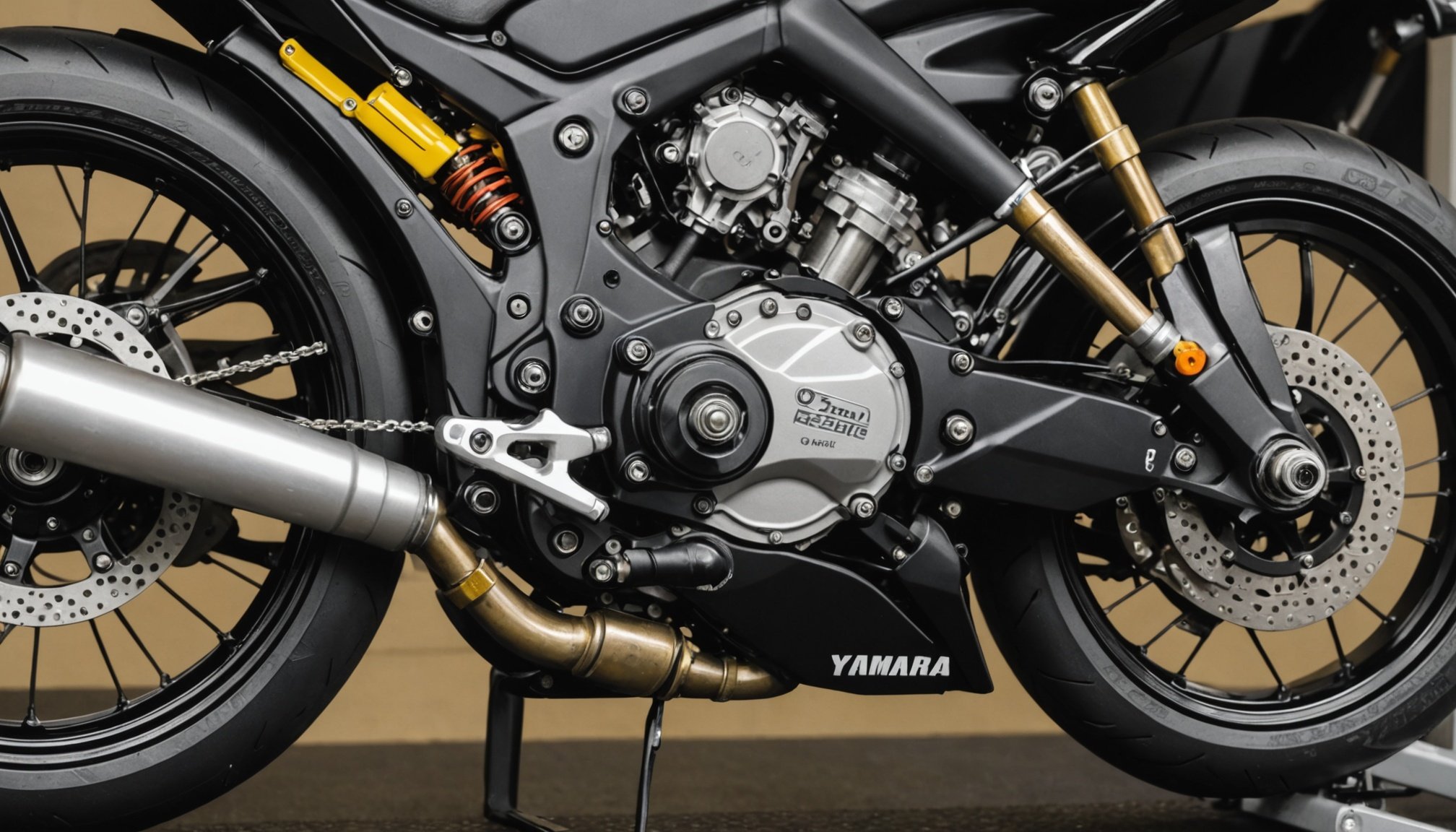Fine-Tuning Chain Tension on Your Yamaha YZF-R1: A Step-by-Step Guide
Understanding the Importance of Chain Tension
When it comes to maintaining your Yamaha YZF-R1, one of the most critical aspects is ensuring the correct chain tension. A properly tensioned chain is essential for the overall performance, safety, and longevity of your motorcycle. Here’s why:
- Performance: A well-tensioned chain optimizes the power transfer from the engine to the rear wheel, enhancing the bike’s acceleration and handling.
- Safety: An over-tightened or loose chain can lead to serious safety issues, including chain breakage, which can result in a loss of control.
- Longevity: Proper chain tension helps extend the life of the chain and other components like the sprockets and engine.
Preparing for the Task
Before you start adjusting the chain tension, make sure you have the necessary tools and information.
In the same genre : Step-by-Step Guide: How to Replace Front Brake Pads on Your Yamaha YZF-R3
Tools Needed
- A ratchet and the correct socket size
- Two wrenches of the correct size for the chain locking nuts
- A torque wrench
- The Yamaha YZF-R1 manual
- A ruler or the notches on the swing arm for alignment
Information to Refer To
- The Yamaha YZF-R1 manual for specific specifications and procedures
- The manufacturer’s recommended chain tension values
Step-by-Step Guide to Adjusting Chain Tension
Loosening the Axle Nut
To adjust the chain tension, you first need to loosen the axle nut. This nut is what keeps your wheel in place, and loosening it allows for free movement of the tire.
- Use a ratchet and the correct socket size to loosen the axle nut. Do not remove it yet.
- This step is crucial as it gives you the flexibility to adjust the chain’s slack or tightness[1].
Undoing the Chain Locking Nuts
Next, you need to undo the chain locking nuts using two wrenches of the correct size.
This might interest you : Unlocking peak performance: the ultimate guide to optimizing the air-fuel ratio for your kawasaki vulcan 900 custom
- Locate the chain locking nuts on either side of the swing arm.
- Use two wrenches to loosen these nuts simultaneously to avoid misaligning the chain.
- Once loosened, you can proceed to adjust the chain tension[1].
Adjusting the Chain Tension
Now it’s time to adjust the chain tension. This is a delicate process that requires careful measurement.
- Twist the appropriate nut to tighten or loosen the chain. Make sure to measure the slack of the chain as you go.
- The ideal chain slack for a Yamaha YZF-R1 is typically between 1.2 and 1.6 inches (30-40 mm). Refer to your manual for the exact specifications.
- Avoid over-tightening the chain, as this can cause damage and potentially lead to the chain snapping[1].
Aligning the Rear Wheel
After adjusting the chain tension, ensure the rear wheel is properly aligned.
- Use the notches on the swing arm or a ruler to check the alignment.
- Make sure both sides are equal to ensure even tension and proper alignment[1].
Checking and Finalizing
Rechecking Chain Tension
After tightening the adjustment nuts, it’s essential to recheck the chain tension.
- Measure the chain slack again to ensure it is within the recommended range.
- Over-tightening can still occur, so double-checking is crucial[1].
Tightening the Axle Nut
Once you are satisfied with the chain tension, it’s time to tighten the axle nut.
- Use a torque wrench to tighten the axle nut according to the specifications in your Yamaha YZF-R1 manual.
- This ensures the wheel is securely in place and the chain tension is maintained[1].
Additional Tips and Maintenance
Periodic Maintenance
Regularly checking and adjusting the chain tension is part of periodic maintenance.
- Check the chain tension every 300-500 miles or as recommended in your manual.
- Lubricate the chain regularly to extend its life and maintain smooth operation[3].
Checking Other Components
While adjusting the chain tension, it’s a good idea to check other critical components.
- Brake Pads: Ensure the brake pads are in good condition. Worn-out brake pads can compromise safety and performance[2].
- Brake Fluid: Check the brake fluid level and condition. Low or contaminated brake fluid can affect the brake system’s performance[2].
- Engine Oil: Regularly check and change the engine oil to maintain optimal engine performance and longevity[2].
- Valve Timing: Although less frequent, checking the valve timing ensures the engine is running at its best[2].
Practical Insights and Actionable Advice
Common Mistakes to Avoid
- Over-Tightening: Avoid over-tightening the chain, as this can lead to premature wear and potential breakage.
- Under-Tightening: Conversely, under-tightening can cause the chain to jump off the sprockets, leading to damage and safety issues.
- Ignoring Alignment: Failing to align the rear wheel properly can result in uneven chain wear and reduced performance.
Tips from Experts
- “Always refer to your manual for specific specifications and procedures. The Yamaha YZF-R1 manual is your best friend when it comes to maintenance,” advises Matt from Laguna Motorcycles[1].
- “Regular maintenance is key. A well-maintained chain can significantly enhance the performance and safety of your motorcycle,” says a mechanic from Motorhelmets[3].
Fine-tuning the chain tension on your Yamaha YZF-R1 is a straightforward process that requires attention to detail and the right tools. By following these steps and incorporating regular maintenance into your routine, you can ensure your motorcycle runs smoothly, efficiently, and safely.
Detailed Checklist for Chain Tension Adjustment
- Loosen the Axle Nut:
- Use a ratchet and the correct socket size.
- Do not remove the nut yet.
- Undo the Chain Locking Nuts:
- Use two wrenches of the correct size.
- Loosen simultaneously to avoid misalignment.
- Adjust the Chain Tension:
- Twist the appropriate nut to tighten or loosen the chain.
- Measure the slack as you go.
- Ideal slack: 1.2-1.6 inches (30-40 mm).
- Align the Rear Wheel:
- Use notches on the swing arm or a ruler.
- Ensure both sides are equal.
- Recheck Chain Tension:
- Measure the slack again after tightening adjustment nuts.
- Tighten the Axle Nut:
- Use a torque wrench according to manual specifications.
Table: Key Specifications for Yamaha YZF-R1 Chain Tension
| Specification | Value |
|---|---|
| Ideal Chain Slack | 1.2-1.6 inches (30-40 mm) |
| Axle Nut Torque | As specified in the manual |
| Chain Type | O-ring or X-ring chain |
| Lubrication | Regular lubrication recommended |
| Periodic Check | Every 300-500 miles or as recommended |
By following this guide and staying vigilant about your motorcycle’s maintenance, you’ll be able to enjoy a smooth, powerful, and safe riding experience on your Yamaha YZF-R1.











